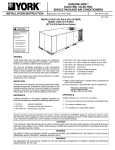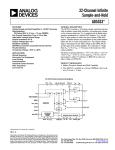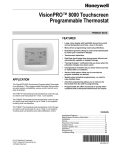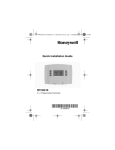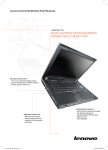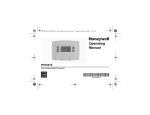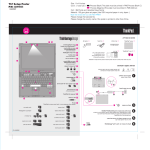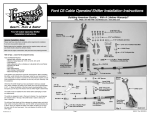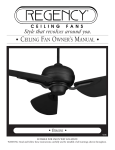Download York 2ET04700224 User guide
Transcript
Programmable Thermostat - 2ET04700224 / 324 / 424 Roof - Top units USER GUIDE <-- THERMOSTATS <-- Table of Contents Page 1 - Specifications ......................................................................................................................................................................3 1.1 - Product range.................................................................................................................................................................................................3 • 2ET04700224 ...........................................................................................................................................................................................3 • 2ET04700324 ...........................................................................................................................................................................................3 • 2ET04700424 ...........................................................................................................................................................................................3 1.2 - General features...........................................................................................................................................................................................3 1.3 - Dimensions ......................................................................................................................................................................................................3 1.4 - Recovery from unoccupied mode .....................................................................................................................................................3 2 - Installation.............................................................................................................................................................................4 2.1 - New installation .............................................................................................................................................................................................4 2.2 - Mount subbase or wallplate ..................................................................................................................................................................4 2.3 - Set subbase dip switches.......................................................................................................................................................................4 2.4 - Set thermostat mini-jumper .................................................................................................................................................................4 2.5 - Set display dip switches ..........................................................................................................................................................................4 2.6 - Mount thermostat .........................................................................................................................................................................................5 2.7 - Install battery ..................................................................................................................................................................................................5 3 - Wiring ......................................................................................................................................................................................6 3.1 - Connections between thermostat and equipment terminals - 2ET04700224 ......................................................6 3.2 - Connections between thermostat and equipment terminals - 2ET04700324 ......................................................6 3.3 - Connections between thermostat and equipment terminals - 2ET04700424 ......................................................6 4 - Programming the thermostat 4.1 - Overview............................................................................................................................................................................................................7 4.2 - Set current time / day ................................................................................................................................................................................7 4.3 - Set program times .......................................................................................................................................................................................7 4.4- Copy a day ........................................................................................................................................................................................................7 4.5 - Set program temperature setpoints .................................................................................................................................................7 4.6 - Set operating display .................................................................................................................................................................................7 4.7 - Clear start time ..............................................................................................................................................................................................7 4.8 - Temporarily override program .............................................................................................................................................................8 - 3 hour occupied ............................................................................................................................................................................................8 - 3 hour occupied with + or - Key .........................................................................................................................................................9 - Set 3 hour occupied Override With + or - Key .........................................................................................................................9 4.9 - Cont Unoc.........................................................................................................................................................................................................9 2 <-- 1 - Specifications 1.1 - Product range 1.3 - Dimensions 2ET04700224 This thermostat may be used with the following units: - All DCE (with or without electrical heaters) and DIG roof top units. 41 204 2ET04700324 This thermostat may be used with the following units : - BCH 036 / 060 (with or without electrical heaters). 2ET04700424 102 118 EM HEAT AUX HEAT FAN AUTO ON This thermostat may be used with the following units : - BCH 090 / 120 and BIH 180 / 240 (with or without electrical heaters). Technical data Description Values EM HEAT HEAT OFF COOL 1.4 - Recovery from unoccupied Intelligent RecoveryTM is a Honeywell trademark for the way the thermostat controls the heating and cooling equipment during recovery from unoccupied to occupied setting. During recovery, the control point ramps up at the rate of 3°C per hour rather than jumping from the energy savings setting to the comfort setting all at once. This provides additional energy savings. Rated Voltage 24-30 Vac, 50/60 Hz Rated A.C Current 1,6 Amps continuous per output with surges to 3,5 Amp Max. Control Range 7 to 35°C; 1°C Steps Thermostat Measurement range 4 to 43°C Control Accuracy ± 0,5° C at 20°C The advantages are: Minimum deadband Between heating and cooling : 1°C Clock accuracy +/- 1 minute per month Default setpoint heating 20°C during occupied period 13°C during unoccupied period - Comfort setting is achieved at the programmed time and maintained regardless of weather conditions; occupants are comfortable. Default setpoint cooling 26°C during occupied period 32°C during unoccupied period Anti recycle time 2 min ON / 4 min OFF Battery backup Up to 60 hours with fresh 9 Volts alkaline battery 1.2 - General features When the Intelligent RecoveryTM is used in the heating mode the control point raises 3°C per hour (2°C for the heat pump), maximizing the use of the more economical first stage heat to bring the sensed temperature to the desired comfort setpoint. This minimizes using the typically more expensive second stage heat. - Drafts from low temperature discharge air are minimized during occupied periods. - The thermostat automatically uses the more economical first stage of heat as the primary heat source during heat mode recovery, avoiding the use of the expensive second stage heating. - Comfort and energy savings can be achieved in both heating and cooling. - The thermostat reduces heat cycling, extending equipment life. • One model can be used for single-stage and multistage applications. • Day programming : two occupied/unoccupied periods per day. • Individual temperature setpoints for: - Occupied heat and cool. - Unoccupied heat and cool. • Proportional plus integral control eliminates temperature fluctuations and thermostat tampering. • Intelligent Recovery : automatically optimises start time depending on building load. • Intelligent Fan energizes fan on call for heating or cooling only. Fan can be configured to run continuously in occupied mode. • Automatic heat/cool changeover. • Locking setpoints and schedules eliminate tampering (user keyboard security). • One thermostat can be used for heat pump or conventional control. • Optional remote sensors. • Convenient overrides allow temporary changes. 3 <-- 2 - Installation 2.1 - New Installation Run cable to a hole at the selected wall location for the thermostat and pull about 75 mm of wire through the opening. Colorcoded thermostat cable with at least one conductor for each wiring terminal is recommended. Good service practice recommends selecting a cable with one or two extra conductors than the immediate application requires. If using remote temperature sensor(s), refer to the mounting instructions included with the device for wiring cable requirements. Route cable away from sources of electrical interference. B Y1 A3 G RC A2 A1 RH W2 CA1 Y2 CA2 T CA3 1 4 T 0 N 1 2 3 4 5 CA4 CA5 LED1 LED2 COM Fig. 2 - Subbase DIP switches 2.2 - Mount subbase or wallplate The subbase or wallplate can be mounted on a horizontal outlet box or directly on the wall. For a wall installation, hold subbase or wallplate in position and mark holes for the screws. See figure 1. Screws and wall plugs must be obtained locally. Be careful that the wires do not fall back into the wall opening. Set aside subbase or wallplate. 2.4 - Set thermostat mini-jumper Note : This operation must be done prior to installing the batteries. If batteries are installed prior to this operation, remove battery for 15 minutes and begin. The thermostat is factory-set for conventional system control. If using with a heat pump 2ET04700324 or 424, locate the minijumper on the back of the display. See Fig. 3. Pull the mini-jumper off the two CONV pins and move to the two HEAT PUMP pins. This changes the thermostat to the heat pump algorithm. If you wish to change the control of the thermostat because a new subbase has been purchased, remove battery for 15 minutes, change mini-jumper position, and re-install battery. B Y1 A3 G RC RH A2 A1 W2 CA1 CA2 Y2 T CA3 CA4 T CA5 LED1 LED2 COM T7300 ONLY 2 1 3 4 INT - FAN ON - KEYBD °F - TEMP 12 HR. TIME INT - FAN °F - TEMP 12 HR. TIME N 2 °C 24 1 5 OFF 0 CON Fig. 1 CONV ON - KEYBD HEAT PUMP 0 N 2.3 - Set subbase DIP switches 1 stage cool Proportional plus integral (P+I) control (droopless) OFF Use remote sensor Energizes fan on heat and cool 1 a. No effect on 2 heat/1 cool Thermostats/ 2ET04700324. b. Factory setting. c. No effect on heat pump subbases : 2ET04700324/424. 4 0 ON - KEYBD Use internal sensor N 2 3 4 0 N 1 2 5 °C 24 5 Energizes fan on cool only OFF ONb CONV Proportional control (allows droop) INT - FAN 4c OFF ONb T7300 ONLY HEAT PUMP °F - TEMP 12 HR. TIME 3 INT - FAN OFF ONb ON - KEYBD 1 stage heat 2 stages cool 3 4 5 OFF OFF ONb °C 24 2a Function 2 stages heat OFF 1a Setting ONb The thermostat DIP switches provide the thermostat with an interface to the single zone HVAC system. See Table 2 for DIP switch settings. The display DIP switches are located on the back of the thermostat. See Fig. 4. Set the DIP switches for the desired thermostat features and the system being controlled. CON Switch 2.5 - Set display DIP switches CON Table 1 - Subbase DIP switch settings Fig. 3 - Setting thermostat mini-jumper °F - TEMP 12 HR. TIME The Subbase provides the Thermostat with an interface to the single zone HVAC system. See Table 1 for DIP switch settings. The subbase DIP switches are located on the front and to the right of the wiring terminals. See Fig.2. Set the DIP switches for the system being controlled. Fig. 4 - Display DIP switches <-- 2 - Installation (cont’d) Table 2 - Display DIP switch settings Switch 1 2 3 Setting ONa °F display OFF °C display ONa 12 hour clock display OFF 24 hour clock display ONa Continuous fan operation in occupied period OFF Intermittent fan operation in occupied period 4 5 Function Non functional switch ONa Keyboard is used for programming OFF Keyboard disabled, but can be used to review program, perform overrides and make clock changes. a : Factory settings. 2.7 - Install battery The 9 volts battery is not necessary for the operation of the thermostat, but holds the program during power outages. When the power is restored, the system will resume normal operation. Without the battery, the system will adopt the default setpoints. Refer to the "technical data". Use the following steps to install a battery : 1. Locate the battery holder on the back of the display. 2. Slide the battery up to the connector until it is firmly seated. Notes : Observe the polarity when snapping a 9 volt alkaline battery into the holder. The plugs must be firmly seated on the connectors for the thermostat to work properly 3. Hang the top edge of the display on the subbase hooks. See Fig. 5. 4. Swing down and press on the lower edge until the thermostat snaps in place. 5. Insert and tighten three Allen head screws on the bottom of the thermostat. See Fig. 5. 2.6 - Mount thermostat Caution Always disconnect power supply and remove battery from the thermostat before connecting the ribbon cables to prevent electrical shock and equipment damage. Use the Following procedure to connect the display ribbon cables to the subbase. 1. Check that the 24 Vac power supply is disconnected. 2. Check that the 9 Vdc battery is not installed in the display. Important : First be sure to connect the 12 pin ribbon cable to the base. 3. Connect the 12 pin (larger) ribbon cable to the display. See Fig. 4. 4. Connect the 9 pin (smaller) ribbon cable to the display. 5. If using a 9 Vdc battery, go to the Install Battery backup section for installation instructions. 1 Fig. 5 - Ribbon cable and display monting 5 <-- 3 - Wiring 3.1 - Connections between thermostat and equipment terminals - 2ET04700224 Thermostat1 terminals Add jumper R Y1 Y2 W1 W2 G B Y2 W1 W2 G B LED 1 LED 2 COM A1 A2 T T X A1 A2 2 Not used 2 24V transformer A1 3 A1 A2 3 A2 E E R R Y1 Y1 Y2 Y2 W1 W1 W2 Add jumper G B LED 1 X 3.2 - Connections between thermostat and equipment terminals - 2ET04700324 Thermostat1 terminals Unit terminal strip TB1 2 N R R Y1 Y1 Y2 3 Y2 W1 4 W1 G G B B O O X X 24V transformer COM LED 1 Not used LED 2 T T To remote sensor 2TH04702224 if used 1. Electronic programmable thermostat 2ET04700324 with subbase for both manual and automatic changeover. 2. Only required on units with economizer. Remove jumper J2 from terminals 4 and 9 on jumper plug P7. The outdoor air intake dampers will return to their fully closed position when the thermostat switches to the "unoccupied" mode. 3. Second stage cooling is only required on units with economizer. Remove jumper J1 from terminals 8 and 10 on jumper plug connector P7. 4. Only required on units with supplemental electric heat. 6 24V transformer LED 2 T Note : Use copper conductors only. Section > 1mm2. 1. Electronic programmable thermostat 2ET04700224 (includes subbase). 2. Terminals Al and A2 provide a relay output when the thermostat switches to the set-back position. 3. Terminal strip TB1 - locate on relay board in 24-volt section of the unit control box. A1 W2 B T A2 2 G COM To remote sensor 2TH04702224 if used Add jumper Unit terminal strip TB13 Thermostat1 terminals Unit terminal strip TB13 RH RC Y1 Add jumper 3.3 - Connections between thermostat and equipment terminals - 2ET04700424 To remote sensor 2TH04702224 if used Note : Use copper conductors only. Section > 1mm2. 1. Electronic programmable thermostat 2ET04700424 (includes subbase). 2. Second stage heating only required on units with supplemental resistance heat. 3. Terminals A1 and A2 provide a relay output when the thermostat switches to the setback position. <-- 4 - Program the thermostat 4.1 - Overview The keyboard is located behind the thermostat flip-up cover. See Fig. 6. There are 16 keys to set, review and modify programmed times and temperatures. The liquid crystal display (LCD) shows day, time or temperature and which programming period is operating. The thermostat can be set for two occupied and two unoccupied time and temperatures for each day of the week (28 independent settings). The two override keys provide quick temporary programming changes for increased occupant comfort. Important : To program the thermostat, 24 Vac is required (turn on System power) and the keyboard lockout switch (see Fig. 4) must be in the ON-KEYBD position. OCCUPIED UNOCCUPIED HEAT 11:32 CONT UNOC AM 3 HR OCCUPIED SET SET START TIME SET TEMPERATURE DATA CHANGE OVERRIDE CLOCK SELECT DAY OCCUPIED START TIME OCCUPIED HEAT OCCUPIED COOL DISPLAY + 3 HOUR OCCUPIED DAY COPY UNOC START TIME UNOC HEAT UNOC COOL CLEAR START TIME - CONT UNOC Fig. 6 - Programming keys and LCD 4.2 - Set current time/day 1. Set the current time by pressing and releasing the CLOCK key once. 2. Press the + or - key until the current time appears on the LCD. 3. Set the current day by pressing and releasing the DAY key once. 4. Press the + or - key until the current day appears on the LCD. Note : Su = Sunday; Mo = Monday; Tu = Tuesday; We = Wednesday; Th = Thursday; Fr = Friday; Sa = Saturday. 7. To program a second occupied start time for the selected day, repeat Step 3 until four dashes ( ---- ) are displayed or the second start time (if previously programmed) is displayed. Then repeat Step 4. 8. To program a second unoccupied start time for the selected day, repeat Step 5 until four dashes ( ---- ) are displayed or the second start time (if previously programmed) is displayed. Then repeat Step 6. 9. Repeat Steps l through 8 for each remaining day of the week or refer to the following section, COPY A DAY. 4.4 - Copy a day 1. Press the SELECT DAY key. The display shows the abbreviation for a day. 2. Press and hold the + or - key until the day to be copied from appears. 3. Press the COPY key. 4. Press and hold the + or - key until the day to be copied to appears. Note : The day to be copied from will remain on the display. 5. Press the COPY key a second time to perform the copy. 6. Repeat Steps 3 to 5 to copy to another day. 4.5 - Set program temperature setpoints Note : The setpoint temperature range is 7°C (unoccupied heat) to 35°C (unoccupied cool). The occupied heat setpoint must be at least 1°C less than the occupied cool setpoint 1. Press the SET TEMPERATURE key (OCCUPIED HEAT, OCCUPIED COOL, UNOC HEAT, or UNOC COOL). The program indicator will point to OCCUPIED or UNOCCUPIED and the LCD will indicate HEAT or COOL. 2. Press and hold the + or - key until the desired temperaure appears. 3. Repeat Steps 1 and 2 until all four temperatures are set. 4.6 - Set operating display 4.3 - Set program times Important : The thermostat will remain in occupied mode from the point of initial programming until it encounters the first unoccupied start time. To avoid the unnecessary occupied period following initial programming, set a 12:00 AM unoccupied start time on the thermostat when programmed. Note : The programming times are in intervals of ten minutes; i.e., 8:00, 8:10, 8:20... 1. Press the SELECT DAY key. The display shows the abbreviation for a day. 2. Press and hold the + or - key until the desired day appears. 3. Press the OCCUPIED START TIME key. The program indicator will point to OCCUPIED. 4. Press and hold the + or - key until the desired start time appears. Note : If a start time is not required, press the CLEAR START TIME key. 5. Press the UNOC START TIME key. The program indicator will point to UNOCCUPIED. 6. Press and hold the + or - key until the desired start time appears. The LCD can show time or temperature. To change the current display, press the DISPLAY key until the desired operating display appears. 4.7 - Clear start time 1. Press the SELECT DAY key. 2. Press and hold the + or - key until the desired day appears. 3. Press and hold the OCCUPIED START TIME or the UNOC START TIME key until the time to clear appears. 4. Press and hold the CLEAR START TIME key until the display shows four dashes ( ---- ). Note : If there is a second OCCUPIED setting, the start for time this setting will appear instead of four dashes. 4.8 - Temporarily override program There are three overrides available. The 3 hour occupied overrides can be initiated from the thermostat. 3 hour occupied The 3 HOUR OCCUPIED key is used to override the unoccupied program when people need to use the area temporarily (working late, weekends or holidays). 7 <-- 4 - Program the thermostat (Cont’d) 1. Press the 3 HOUR OCCUPIED key to change the unoccupied temperature setting to the occupied setpoint for three hours. 1. Press the 3 HOUR OCCUPIED key to change the unoccupied temperature setting to the occupied setpoint for three hours. Note : The program indicator will point to 3 HR OCCUPIED while the override is in effect. 2. Press the + key to increase or press the - key to decrease the occupied setpoint by the key value. 3 hour occupied with + or - Key When using the + or - key with the 3 HOUR OCCUPIED key, the + or - key has a preassigned value of 0 to 3°C (default is 0). Use the following steps to check or change the value: 1. Press the 3 HOUR OCCUPIED key. The program indicator will point to 3 HR OCCUPIED. 2. Press the DISPLAY key. The LCD will show a number from 0 to 3. Example : Unoccupied setpoint is 17°C, occupied setpoint is 21°C and key value is 1,7°C. Pressing the 3 HOUR OCCUPIED key and the + key will change the setpoint from 17°C to 21°C plus 1,7°C or ~23°C. Pressing the - key would change the setpoint to 21°C minus 1,7°C or ~19°C. Note : The program indicator will point to 3 HR OCCUPIED while the override is in effect. The LCD will not reflect the key value. 3. Press the + or - key to change the value. 4.9 - Cont Unoc 4. Press the DISPLAY key to return to the program. The continuous unoccupied override feature holds the setpoint at the unoccupied temperature setpoint until the DISPLAY or CONT UNOC key is pressed. This override is used when the area will be closed for a temporary period such as a long holiday. Set 3 hour occupied Override With + or - Key The 3 HOUR OCCUPIED key with the + or - key will override the unoccupied program for three hours with the occupied temperature setpoint +/- the preassigned key value (see Set + or - Key Value section). 8 1. Press the CONT UNOC key to hold the temperature at the unoccupied setpoint. 2. Press the CONT UNOC key again to return to the program. <-- <-- CUSTOMER INSTALLATION UNITARY equipment Simplified Diagram Notes Europe <-- <-- E - UG - R9702 Printed in France Europe Manufacturer reserves the right to change specifications without prior notice.












